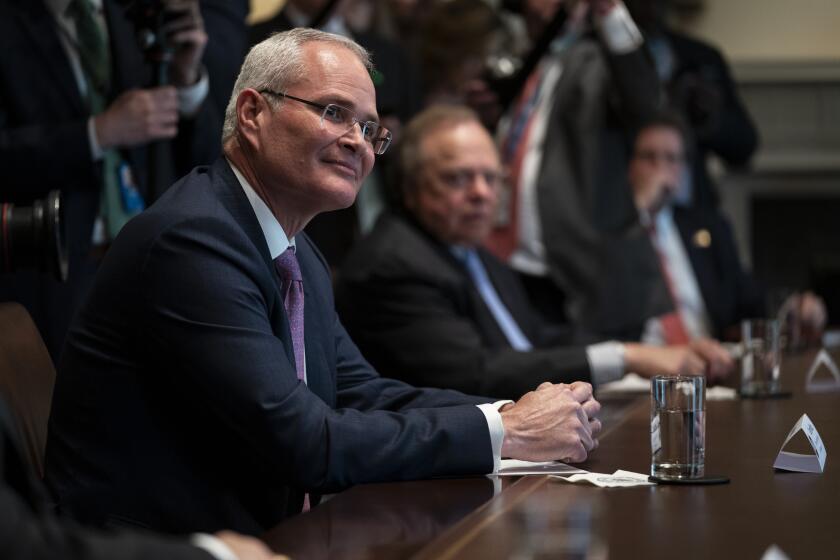Column: Investing through index funds is more popular than ever, so why is it becoming controversial?

- Share via
The share of adult Americans who own stocks is approaching an all-time high of 63%, which may explain why events such as the surge in “meme” stocks like GameStop gets such generous play in the news.
But it doesn’t explain why the investment vehicles that dominate Americans’ portfolios — passive mutual funds tied to market indexes such as the Standard & Poor’s 500 — have traditionally drawn so much less interest in the news media.
That may be changing, thanks to concerns about index funds expressed across the partisan spectrum. To put these concerns simply, Democrats and progressives are uneasy about the concentration of investment power in the hands of a few fund management firms that vacuum the vast bulk of investment dollars into their index funds, notably BlackRock, Vanguard and State Street.
Control of most public companies...will soon be concentrated in the hands of a dozen or fewer people.
— John C. Coates, Harvard Law School (2018)
Republicans and conservatives also fret about the concentration of power, but their concern is more specific — they complain that the passive fund managers deploying $15 trillion in assets globally are surreptitiously pushing a liberal agenda on corporate managements, especially in “ESG” categories, the environment, social issues and corporate governance.
That was the claim of 21 red-state attorneys general, who groused last year in letters to the big asset management firms that they appeared to be pressing managers of their portfolio companies to act against global warming (as though that’s a bad thing).
Get the latest from Michael Hiltzik
Commentary on economics and more from a Pulitzer Prize winner.
You may occasionally receive promotional content from the Los Angeles Times.
More on that in a bit. First, a primer on passive investing and why it attracts so much money.
As so many investors have learned from bitter experience, trying to pick individual winners in the stock market is a mug’s game.
Doing the financial analysis necessary to judge the potential gains of individual stocks is a full-time job, and most people already have full-time jobs. Few have the financial resources to brave the periodic downdrafts in the stock market without quailing. (As J.P. Morgan supposedly advised a friend who said he was so worried about his portfolio that he couldn’t sleep at night, “Then sell down to your sleeping point.”)
Enter the index mutual fund. Jack Bogle of Vanguard launched the first such fund to be widely marketed to retail investors in 1975. It was designed to match the performance of the S&P 500 simply by replicating its holdings and their weighting in the index. It was, in short, a way for the average investor to ride the ups and downs of the stock market effortlessly.
CalPERS, the nation’s biggest public pension fund, makes good on its support of shareholder rights by voting against all 12 Exxon directors.
Index funds have several virtues. Because the makeup of the 500 index changes only rarely, the 500 fund and funds like it make few purchases or sales. That reduces transaction costs, which allowed Bogle to keep fees low. They’re also tax-friendly — because they don’t have to sell stocks very often, they incur minimal capital gains taxes, which would be passed through to its investors.
The Vanguard 500 fund, along with other index funds, exposed the dirty little secret of the brokerage industry: “Active” fund managers, who bought and sold vigorously to dump losing stocks and ride winners, seldom did better than the broad market.
Over the last year, only about 40% of actively managed large-company funds did better than the S&P 500 index, according to S&P’s SPIVA scorecard (for “S&P Indices Versus Active”). Over the last 10 years, only about 12.6% of large-cap funds beat the S&P 500.
It’s true that a stock-picker here or there will have a successful run, but rarely for more than a few years. The most famous, Peter Lynch of Fidelity Investments, had a gilt-edged run from 1977 to 1990, during which he built Fidelity’s Magellan Fund from $18 million in assets to $14 billion. In that time span Magellan averaged an annual return of 29%, possibly the most successful such run ever.
But Lynch had some advantages that are rarely noted: For the first four years of his management, Magellan was a private investment fund for Fidelity’s founding Johnson family; it wasn’t opened to outsiders until 1981. For years after that it was relatively small, which is almost always an advantage for fund managers.
By the end of Lynch’s tenure Magellan was a behemoth struggling to eke out “a razor thin margin of victory,” as an investment expert put it. Magellan actually fell behind the S&P 500 in two of Lynch’s final four years of management.
Exxon Mobil objects to the Securities and Exchange Commission’s rule on shareholder proposals. So why is it suing these small investors instead of the SEC?
That’s not unusual. Fewer than 5% of all actively managed funds remain in the top half of funds by performance for even five years.
So it’s not surprising that passively managed index funds have outrun active funds for years. Finally, as of the end of December according to Morningstar, assets in passive investments including mutual funds and exchange-trade funds exceeded those in active investments, $13.29 trillion versus $13.23 trillion. That gap is destined to widen.
But that success has generated a backlash. The issue boils down to whether there can be too much passive investing and if so, how much is too much.
What unnerves some market experts is that passive investors by their nature don’t care what they’re buying — in fact, they usually don’t even know. (How many owners of Vanguard’s S&P 500 index fund can name even 10 stocks in the index?) That relieves them of the chore, even the duty, of making judgments about a company’s future, its competitive behavior, its prospects.
A 2014 academic paper suggested that, because index fund investors are likely to own all the major competitors in a given industry (because all are in the S&P 500), aggressive competing by one will reduce the value of the others, possibly lowering the value of the index.
So pressure on corporate managers to increase market share evaporates, and the industry begins to resemble a monopoly, which produces a “loss for the economy and adverse consequences for consumers.”
A related drawback comes from the dominance of the passive asset business by a small number of huge brokerage firms. This is what legal expert John C. Coates of Harvard Law School called “the problem of twelve” — that “control of most public companies ... will soon be concentrated in the hands of a dozen or fewer people,” namely, the top managers of the biggest passive investment firms.
They, not individual investors, will decide what corporate policies should be, and they’ll have access to trillions of dollars in assets belonging to billions of uncaring investors to make their own views heard.
The National Labor Relations Board based its joint-employer rule on the reality of today’s workforces. So of course a Trump-appointed judge overturned it.
That’s the prospect that had the red-state attorneys general vibrating.
“You are not the same as political or social activists,” they wrote, “and you should not be allowing the vast savings entrusted to you to be commandeered by activists to advance non-financial goals.” Among those goals, they wrote, is changing corporate behavior “so that it aligns with the Environmental, Social, and Governance (ESG) goal of achieving net zero by 2050.” (That is, achieving neutral impact on global warming by that year.)
There are a couple of problems with the red-staters’ argument. For one thing, there’s no evidence that ESG policies are necessarily at odds with the goals of the average investor, who may indeed favor increasing diversity and fighting the threat of global warming. Some investors may indeed see the improvement of social and environmental conditions as a responsibility of corporate managements.
Another problem is that defining racism and global warning as “non-financial” problems is a crabbed, highly partisan and erroneous viewpoint. A company that allows racial discrimination to reign on its factory floors is asking for regulatory problems and for a loss of customers. There are precious few businesses that will be immune from the costs of global warming, which could force them to close or relocate plants or deplete their profits.
The authors of that threatening letter are performing for what may be a very narrow and shrinking voting base. They’re the ones who may be pushing “non-financial” policies on corporations; they’re just too blind to see the possible costs of the status quo. They’re backed by right-wing organizations.
That said, the concentration of financial power in passive investment funds has raised concerns in Washington, and not only among conservatives. In April, the board of the Federal Deposit Insurance Corp., a major federal bank regulator, began pondering whether the biggest index fund firms may own enough shares in banks to exercise unwelcome policy control.
Vanguard has a long history of denying its customers access to investments it believes are dumb. Now it has added crypto to the list.
Members of the FDIC board — Republican Jonathan McKernan and Democrat Rohit Chopra — met jointly with executives from BlackRock and Vanguard to get a better sense of their bank holdings, the Wall Street Journal reported.
Nothing has come of those meetings as yet, but the big passive investment firms have taken steps to give their investment customers more say in how their shares are voted on shareholder proposals at corporate annual meetings.
Up to now, the firms have done the voting of what may be sizable holdings in stocks in individual companies, often following the lead of proxy advisory services such as Glass, Lewis & Co. or Institutional Shareholder Services. Starting in 2022, BlackRock afforded clients in some of its funds to make their own voting decisions.
The firm says that by the end of last year, investors in funds valued at $2.6 trillion of its $5.2 trillion in equity index funds were eligible to participate in what it calls Voting Choice; clients with $598 billion in holdings in those funds participated.
Vanguard introduced a pilot program along the same lines last year and expanded it this year. Investors in five of its equity index funds can choose from among four approaches: casting votes consistent with a portfolio company management’s recommendations; voting along with the ESG recommendations of Glass Lewis; leaving their vote up to Vanguard; or not casting a vote at all.
Whether that will quell the backlash against concentrated passive investing isn’t clear just yet. It may energize more investors to pay attention to the companies in their index funds. Or, given that retail investors are known not to bother voting on shareholder resolutions, it could even strengthen the hand of the big firms in seeking to guide policy of indexed corporations.
The only thing that everyone seems to agree on is that passive investing does better than active management — at the moment. Whether or when that tide will turn ... who knows?
More to Read
Get the latest from Michael Hiltzik
Commentary on economics and more from a Pulitzer Prize winner.
You may occasionally receive promotional content from the Los Angeles Times.















